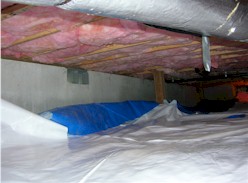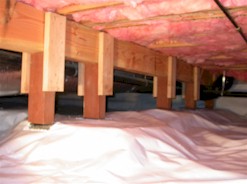Dear Subscribers,
Though I have not posted a great deal on mold recently, hardly a day goes by that someone does not relate a mold story . . . and, unfortunately, each story bears significant resemblance to the other stories so while this is very little consolation for anyone, there might be less sense of isolation and loneliness if these facts were better known. Officially, and this includes medical professionals, lawyers, contractors, rental agencies, and probably a lot of realtors, most people with mold complaints are either regarded as oversensitive or somehow imbalanced . . . and there is, of course, practically no higher insult to otherwise sane and sensible people than to have it inferred that there is nothing wrong with the building and the problem is the complainer, not the property. It's actually demeaning to the sufferer so I would like to go on record saying that the purpose behind this strategy is to reduce law suits and consequences of bad practices in the construction industry and there is no medical truth in the notion that something is wrong with the sufferer rather than the property.
My sense is that relatively few people quit their jobs just because their work places are unsafe and even fewer people abandon their homes because of mold. However, if a place is contaminated, the people who occupy those structures are truly between a rock and a hard place. When you feel like you cannot hold it together any more, it does not feel safe to quit a job or live, as my lawyer suggested, on a park bench. I am actually astonished at the irresponsibility of those who use their official capacities to recite propaganda supplied by the construction and insurance industries who are in cahoots with industrialized medicine and its bogus notions of what health is and isn't.
If you do not own a property, I am quite certain the best course of action will almost always be to leave, including breaking your lease if necessary. Then, the landlord is forced to remediate in order to collect rent or he is faced with the legal risks of non-disclosure and failing to reveal hazards when duping unsuspecting tenants. However, if you are the property owner, you need to choose between abandoning the property and remediating it. There are circumstances that favor one or the other action because there are times when remediation is simply not cost effective and health and survival are more important. I think that with real estate values falling through the floor, remediation is a serious financial consideration, but there are tasks that not prohibitively expensive that will pay off handsomely in terms of higher productivity and efficiency once the hazards are removed.
Step one must be to remove materials that are contaminated and then to limit moisture intrusion. In some cases, this entails removing a few tiles in the bathroom or kitchen, a small piece of drywall, and replacing some sealants in pipes. In other cases, it means rerouting rainfall and remediating a basement or crawl space. The water that falls onto the roof or ground must not seep through the foundation walls under the living space in the home or work place. This is very important and if the measures required to prevent moisture from penetrating these spaces have been ignored for some time, odds are that some parts of the foundation may need to be replaced or treated with serious retardants.
A significant percentage of the indoor air quality is determined by the condition of the crawl space because warm air circulates so any improvement in the less used spaces affects the most used spaces in a positive manner. I spent a tiny fortune on remediation because there were fewer well-informed people to be found years ago than today and there were fewer options and probably fewer hoaxsters as well.
People recommended everything from baking soda to ozone but regardless of the potential for these to be effective, they do not obviate the need for proper remediation so step one is to eliminate moisture intrusion; step two is remove contaminated materials and replace them with clean ones; and step three is to create an adequate vapor barrier between moisture in the ground and the underside of the floor of the occupied space.
Moisture intrusion can be as simple as tightening a connection on a pipe, improving air circulation where there is a tendency for condensation to form, fixing a downspout, or rerouting runoff. It can be monumentally difficult if the house is built on marshy land or rainfall is so persistent that nothing ever dries out completely. I am trying to think of everything from the Pacific Northwest where I live to the Bayou to the tropics to land that is lower than sea, like much of Holland.
 |
This material is spread out under the house, directly onto the dirt. The seams are taped together, and the edges are affixed to the foundation walls using a caulking material. Warning: it pays to find an odorless caulk. |
 |
The material is neatly wrapped around posts and caulked so that neither moisture nor vapors from under the protective barrier rise into the occupied space above the crawl space. I ran experiments with essential oil to see how long it took to detect the smell if opened in the crawl space: seconds! |
In our hastily thrown together stick houses, there is usually some visqueen thrown under the house, but the seams are not sealed with anything and the edges are not attached to the foundation walls or posts, meaning whatever is off gassing under the vapor barrier is part of your indoor air quality. If the vapor barrier is in decent condition, a few rolls of extremely wide tape and some extra sheeting to use around the posts and perimeter might be enough of a solution and very affordable compared to removing what is there and starting over from scratch. I started over from scratch because while new, the organic material under the visqueen had not been removed so the mold growing on that was literally killing me and did kill some of my pets.
I cannot urge anyone strongly enough to do whatever necessary to seal the crawl space and basement:
http://www.moldmisery.com/remediation/crawl_space.html
The persons doing this work should be properly suited up in disposable Tyvek suits, which are just a few dollars, and they need respiratory masks and work breaks.
All the research done with essential oils is proving over and over again how effective they are. Even in very humid places, they inhibit growth of mold for at least two years. Obviously, this is not good enough, but if all that is involved in future maintenance is spraying some eucalyptus or cinnamon under your house, this is not too unthinkable to consider.
Most professional remediators want to sell you very expensive whole house dehumidifiers. The folks that I consulted about fixing my house were so convinced that I would buy one of these systems that they installed one in the crawl space and when I said I could not bear the smell, they moved it to the garage and it was just as horrific. I ended up with small portable units, only in the garage. and they are removing enough moisture every day to keep the place rather dry. The day someone designs a silent unit that does not off gas cheap plastic or ozone, that comes with a hose to drain outside, and that has proper displays for temperature and humidity, they will make a fortune. There are a lot of models in the $200-300 price range and each has some pros and cons, but then there is more or less a leap in price without any real increase in features and then another leap, but I have yet to see someone with his engineering act together. I like features ! of this one and that one but have not seen anything in what might be called an affordable appliance range that has nothing major on the con side. This said, you can dehumidify effectively for under $300 if you can tolerate the odor of unstable plastics and manual emptying of containers. The odor of the plastics subsides eventually, but why can't our corporations get this job done right?
Once the space is dry, you can start cleaning up the aftermath of contamination and some of this is going to be stressful. Look at it this way: if you have to move, you incur a lot of expense and you spend time packing and unpacking or paying someone to do it for you. If you take that same budget and spend it on your space, you may come out ahead, especially since finding a safe place is not that easy. Realtors have told me more or less off the record that they feel all homes in Texas have mold. If this were true, I would be rich if I ran a mold remediation business in Texas or sold antifungal remedies for all the folks with allergies and asthma and coughs that never stop, but I am not rich so either the problem isn't recognized or people aren't taking their complaints seriously.
In the next days, I will try to zero in on the health consequences of ignoring mold.
In the meantime, take care and many blessings,
Ingrid
Copyright by Ingrid Naiman 2008


